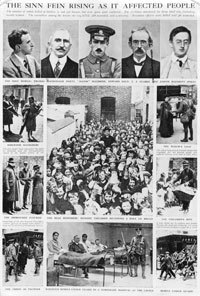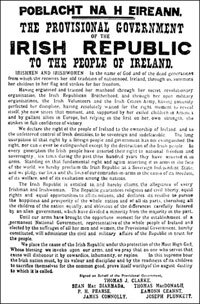Truth matters. Community matters. Your support makes both possible. LAist is one of the few places where news remains independent and free from political and corporate influence. Stand up for truth and for LAist. Make your year-end tax-deductible gift now.
Historic Irish Prison Houses Spirit of Independence


Dublin's Kilmainham Jail is a repository of Ireland's rebellions and inspirations, and like the Bastille in France or the Tower of London, it exposes Ireland's historical conflicts and passion. Built in 1796, the gray stone fortress — bare, cold and full of echoes — is one of Ireland's most visited national heritage sites.
Kilmainham was modeled on the British prison Pentonville and has the classic three stories, three galleries and open skylight associated with progressive prisons of its day. The cells were for individuals and had high ceilings. Almost immediately after it was erected, rebels began to be housed there, beginning with Henry Joy McCracken, leader of a rebellion in 1798. During the Irish famine of the 1840s, almost 9,000 people were incarcerated there — many because they knew they would be fed and not starve.
Today tourists can pass below the jail's massive doorway, walk its windy galleries and peer into its high, empty cells. Above one stone doorway is an inscription scratched by a former prisoner: "Beware the Risen People who have Harried and Held, Ye that have Bullied and Bribed." Those words were penned by Padraig Pearse, one of the authors of the Irish Proclamation of Freedom announced on April 24, 1916. Their armed resistance in Dublin ultimately led to the creation of the modern Irish state.
Pearse, commandant-general of the Irish Republican Brotherhood, and military strategist James Connolly, along with others, helped lead a band of roughly 2,000 rebels that Easter Monday. The two men were the ideological descendants of many nationalistic forebears who had sought to overturn British rule and domination in Ireland for more than 200 years. When they took over the imposing General Post Office on Sackville Street (later O'Connell Street) and other key buildings, Pearse read from the proclamation, which declared formation of the "Provisional Government of Ireland."
"Irish men and Irish women: In the name of God and the dead generations from which she receives her old tradition of nationhood, Ireland, through us, summons her flag and strikes for her freedom," Pearse read. Only weeks later, England would execute Pearse, Connolly and 12 other men at Kilmainham. Though at first the plotters were barely tolerated, the executions galvanized the Irish public against the British government.
Former Executive Director Pat Cooke, who ran Kilmainham for more than 20 years, says the prison reflects key moments of crisis in Irish history and Irish political history through the 19th century.
"I think one of the dimensions of history that most historians miss out on is the emotionality of it. They're uncomfortable with it. But you can't manage a building like this without being aware of the sensory and emotional dimensions of history. If you stand on the landing outside the door of that cell where Padraig Pearse was kept for the hours before he was executed, you're almost existentially re-enacting the last footsteps of a man at the very point of execution," Cooke says.
As affecting as the corridors and execution yard are, there is a tender and poignant side to Kilmainham. It is home to a pair of glasses belonging to Joseph Plunkett, who married his sweetheart, Grace Gifford, in the chapel the night before his execution. There is also a Christmas card made by Pearse's mother, showing his likeness and that of his brother, Willie, who was executed as well. A little girl sent another prisoner a box of chocolates, which he promised to eat with her if he were freed. They remain untouched.
The 1916 Easter Rising was followed by years of instability and violence throughout Ireland. It led to Ireland's War of Independence in 1919, which lasted for two years and which was partially settled by the Anglo-Irish treaty, which partitioned Ireland and created the Irish Free State. Opposition to the treaty led to civil war from 1921 to 1923. After 77 more prisoners were executed in the Civil War, four of them at Kilmainham, the jail was abandoned for almost 40 years and never reopened as a working prison. The jail was restored beginning in the 1960s and is now a national heritage site.
Cooke hopes that everyone interested in the history of Ireland — which was declared a republic at the end of 1948 — visits Kilmainham Jail and Pearse Museum.
"Of course, there's always a danger that by going to one place you're going to oversimplify," Cooke says. "But it is an uncanny fact that Kilmainham Jail can authentically reflect key moments in Irish history by simple virtue of the fact that so many of those people were actually in here and stories can be told about them and articulated through a sense of place."
Copyright 2022 NPR. To see more, visit https://www.npr.org. 9(MDA1OTI3MjQ5MDEyODUwMTE2MzM1YzNmZA004))








